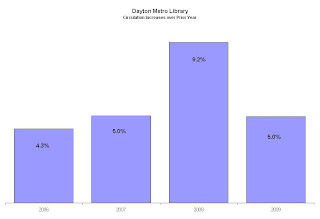The (not so) Big Lie
It has been easy for us librarians to talk about the increased relevance of public libraries today. We can talk with conviction about the work we are all doing to improve early literacy and kindergarten readiness. We’ve been major contributors to workforce development with our massive expenditures in public computing access and free classes. I share the pride.
“We have been busier than every. We’ve seen more than a 25% rise in use since our last levy…” was a part of our battle cry during last November’s levy campaign. And it is true that library visits, reference transactions, program attendance and other measures of output have risen substantially since 2004, but it has been circulation statistics that we cited during the campaign. Again, I share the pride – but with hesitancy.
Circulation counts, a key measure in rating and ranking systems such as HAPLR Index and even more so in the LJ Index, have been a strong factor in making management decisions over the past century of modern public library service. Our collection development staff uses them to decide how to allocated materials budgets and branch staffing decisions are often driven by how many items are borrowed by location. As a tool for seeking community and funding support, circulation is an easy measure to understand. It invokes warm and fuzzy feelings with images of a smiling young children assisted by helpful and professional staff.
In recent years our library implemented a more enlighten series of policies to ensure that we aren’t creating barriers to access. In particular we lowered overdue fine rates 90% for videos and eliminated them altogether for children’s books. We also increased the number of times someone could renew items. Circulation shot up dramatically, by nearly 10% in one year alone. Our rust-belt stained Midwestern economy certainly helped drive up circulation in the past year, but the most dramatic increases came before the recent recession.
The reason for my hesitancy to applaud with enthusiasm boasts of record increases by my library and my peer institution is because in the back of my mind I’ve increasingly seen these statistics as tainted. I worried that that the increases in circulation are driven too much by renewals. I have assumed that most of these increases in circulation are a measure of an increase in Internet savvy patrons taking advantage of our “renew all” button on our web site. I don’t take much pride in the fact much of our library’s increased circulation could be because it’s easier to click a web site button than dig under the car seat looking for that long finished audio book.
Counts from our IT staff confirm this. We have seen a 146% increase in online renewals by patrons. We are also beginning to see a drop in the number of staff assisted renewal that may be done on site or via a phone call. Last year staff assisted renewals dropped 8.3%.
These trends are great to see from a library efficiency perspective. As with our self-charge circulations which now exceed 90% at most of our branches, we are able to redirect library staff away from routine activities such as scanning barcodes to more meaningful contributions such as being in the stacks providing readers advisory services.
There are other benefits for these more lenient renewal policies. Certainly the number of patrons owing fines is probably less, thus reducing the number of expensive and often confrontational interactions at the circulation desk and satisfaction with library services is probably less.
I have no qualms about extending renewal limits. They allow us to have larger and thus more diverse collections than our shelf space provides. We have to weed less. However, these counts are increasing losing their value as measure of library success or staff effort. They may help with boasting rights and they help me get stars, but they mask the real gains that libraries have made.
It took some extra digging on my part to find out that we have been we have seen steady increases in first time circulation. No, it hasn’t been the 25.5% that you’ll find reported to the State Library, but we have seen a substantial 16.8% increase since our last levy. Still something to boast about, but more importantly these are numbers I don’t fee are tainted.
What I don’t know is whether those inflated circulation counts are consistent around all of our branches. Are the online renewal statistics disproportionately attributing activity to our suburban branches because they have a higher penetration of patrons with Internet access? Am I deploying resources to these locations at the expense of urban branches? I am certain I can get branch level counts of first time circulation but I have to admit that I just don’t know.
Library Journal asked its Star libraries to suggest what new measures should be used to improve the Index. I didn’t suggest any new class of statistics. I only ask that the existing measures be changed to better reflect what matters. Dropping renewal counts from circulation statistics is one change that would make me proud.
Labels: circulation, LJ Index, public library



